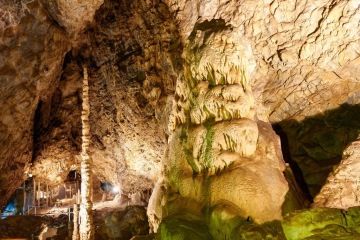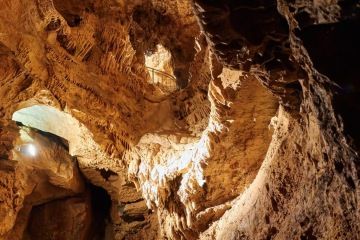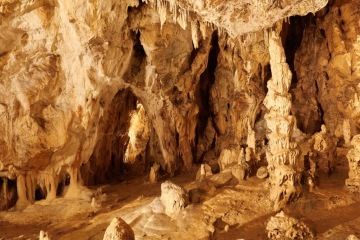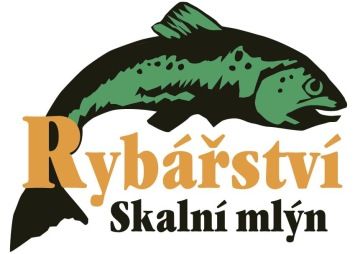MORAVIAN KARST
The Moravian Karst is one of the most noted karsts found in the Central Europe. More than 1000 caves have been discovered in the area. Five of these are opened to the public. In the Punkevni Caves, the visitors have a rare opportunity to take a boat trip on underground river, the Punkva, and make excursion of the bottom of the Macocha Abyss. The other caves are the Catherine Cave, renowned by its unique rod stalagmites, the Balcarka Cave with its wealth of colorful dripstone ornamentation, and the Sloupsko- Sosuvske Caves, consisting of huge corridors and underground abysses.
The Moravian Karst National Natural Reserve spreads over area of about 100 km2. We definitely recommend making the telephonic reservation of tickets to the caves during summer months! The most frequented part of the Moravian Karst - Pusty and Suchy Zlebs - has been closed to all motorcar traffic. Instead, there are ecological means of transport at visitors' disposal - a road train and a cabin cable way. The train connects the complex of Skalni Mlyn and the Punkevni Caves and the Lower Station of the cable way. The cable way connects the Punkevni Caves and the Upper Observation Bridge of Macocha Abyss.
The Punkevni Caves are found in Pusty Zleb, 2 km from Skalni Mlyn information center, upstream of the Punkva river. The caves were discovered in stages, during the period of 1909-1933 (1909-1914 the dry part of the cave; 1920-1933 the water navigation) by the working group of Prof. Karel Absolon. The visitors pass through huge chambers and corridors with dripstone ornamentation to the bottom of the Macocha Abyss. The abyss is 138 m deep, the dimensions of the area in plan view are 174x76 m. Another part of the excursion route is the trip on motorboats on underground river, the Punkva. The boat trip includes the viewing of Masaryk's Chamber, which is said to be the most beautiful chamber of the Punkevni Caves. The caves form a part of the longest cave system in the Czech Republic - the Amateur Cave. The length of corridors of this cave is more than 30 km.
South of Ostrov u Macochy, at the eastern edge of limestone hills of Moravian Karst, in the core of the rocky meander of Suchy Zleb, is hidden the five meters high mouth of the Balcarka Cave. The front part of the cave has been known from time immemorial. The Balcarka is famous for discoveries of remains of hearths and various tools dating from Paleolithic Age, and remains of animal bones dating from Quaternary Period. From 1923, other caverns were discovered in stages by explorers from Ostrov, until in 1936 the individual caverns were joined into one whole. The caves form a complex system in two levels that are linked by two high chambers. The caves were created by water of the Lopac and Krasovsky brookes, sinkholes of which can be found north and south of the cave. The Balcarka attracts visitors in particular by its variety of dripstone ornamentation concentrated in a relatively small area. Exceptional wealth of drip stones, typically developed surface karstic forms (sinkholes, karrens), numerous archeological and Paleolithic findings, rare thermophilic species of flora, and picturesque landscapes make the Balcarka one of the most interesting spots in Moravian Karst.
About 300 metres before the connection of the Suchý and Pustý žleb karst canyons near Skalní mlýn, the 8-metre high entrance to the Catherine Cave opens in the right valley slope of Suchý Žleb. It is the outlet cave of the Punkva River, which in the geological past flowed out of the Macocha Abyss through previously unknown passages to the southwest and flowed through the Catherine Cave into the Suchý Žleb. The cave consists of two interconnected massive domes with adjacent passages. The parts closer to the entrance were inhabited by an older Stone Age man, whose remains have been found in the cave clay alongside the bones of Quaternary animals, especially bears (a unique find is the mass discovery of cave bear skeletons in one of the cave chimneys). The cave was opened to the public in 1910. Today, it provides visitors with an exciting experience not only to see the unusual stalactite decorations, but especially the fascinating evidence of the extensive caving of the ceiling of the underground cavities, which in the past led to the formation of the largest domes in the Moravian Karst. The main dome, measuring 95x44x20 metres, is the largest underground space in the Moravian Karst open to the public. The excellent acoustics of the dome are occasionally used for singing and music concerts. Another part of the cave is the new Catherine Cave discovered in 1909. Among the most beautiful parts are the colourfully illuminated formation of the Witch and the Bamboo Grove made up of rare stalagmites several metres high.
This is a vast complex of chambers, corridors, and huge underground chasms, consisting of two levels. The cave is an important location of discoveries of animal skeletons - such as of cave bears, lions, hyenas, and other animals. The area called Eliska's Cave has very rich dripstone ornamentation and also excellent acoustics, and it is for this reason that concerts of chamber music are occasionally held here. In 1997, during reconstruction work, a bridge was built over the Stupnovita propast ('The Cascade Abyss'), and a new and non-traditional view has thus been opened to the visitors. The Nagel Abyss, 80 m deep, is the largest underground abyss of its kind in the Czech Republic. The visitors can view it from two observation bridges. A part of the excursion route is also the world-known archeological site - The Kulna Cave, where parts of the skull of Neanderthal man, about 120 000 years old, were found. The Sosuvska part of the cave, discovered at the beginning of 20th century, is characterized by its dainty and colorful flowstone ornamentation.In northwest tip of the Moravian Karst is the oldest known cave in this country. It is here that the exploration of caves and archeological activities in the Moravian Karst began. The village Sloup ('Pillar') was called that since the time immemorial, after a limestone pillar 'Hrebenac', that is towering so prominently over the sinking of the Sloupsky Brooke.
The Vypustek Cave
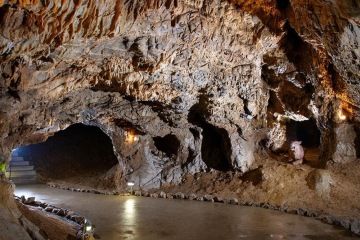
The Výpustek Cave is a wide and unique underground system created many centuries ago. Nevertheless, its areas were significantly affected by phosphate clay exploitation and activities of both the Czechoslovak and the German armies during the 20th century. In the sixties an underground fallout shelter and a secret command post were created in one of the corridors. Visitors will learn about the whole history of this unique cave, including the last “socialist secret bunker”.
The Macocha Abbys
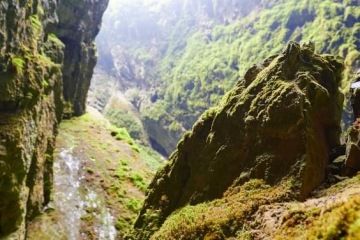
The Macocha Abyss is the deepest open abyss in the Czech Republic (and in the Central Europe). It is 138.7 m deep - measured from the Upper Observation Bridge down to the bottom of the abyss. This imposing rarity was formed when the roof of an enormous underground chamber collapsed. There are two small lakes at the bottom of the abyss, fed by underground river, the Punkva. It is possible to reach the bottom of the abyss from the Punkevni Caves that are opened to the public. It is one of the most famous and beautiful formations of the Moravian Karst. It is accessible to tourists from two observation bridges. The Upper Bridge is located at the top edge of the abyss, in close vicinity to Utulna by Macocha, and the second one, the Lower Bridge, from which there is a beautiful view of the lower part of the abyss, is placed at the height of 90 m above water level of the lower lake. The Macocha Abyss is the most visited abyss - and this is not surprising. Evidently and unfortunately, it is also popular with people who wish to commit suicide, since more than 50 people ended their lives here. Transport - You can reach the orifice of the abyss comfortably either by taking a bus or you can park your car in supervised parking. If you decide to drive, please bear in mind that the road between the Skalni Mlyn (i.e., coming from the direction of Blansko) up to Macocha serpentines is closed to traffic. It is necessary to take the road leading through Vilemovice and Lazanky. From the Punkevni Caves, you can travel elegantly by using the cable way. The more fit tourists can follow the footpath. There are ample refreshment facilities by the abyss, a wide selection of souvenirs, and there is even accommodation available there.
